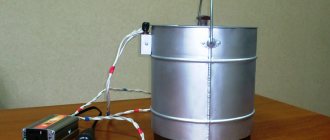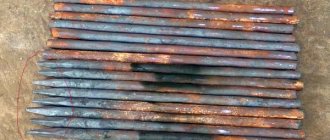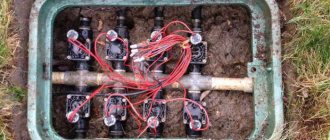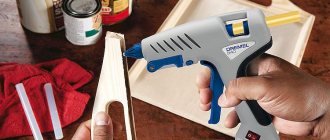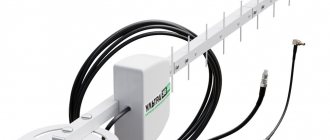For individual water supply, borehole and well sources of clean water are used, the intake of which is carried out using submersible or surface electric pumps. They cannot operate continuously and must be turned off as the main line fills; the cycles of turning on and off the electric pump are controlled by automation for the well or well.
When organizing a water supply system for a private home, an electric pump is selected based on flow rate, after which an automatic control system for its operation is installed, including electronics and a storage tank. The efficiency of water supply, the service life of the electric pump and the ease of use of the water supply depend on the correct selection and configuration of electronic control devices.
Fig. 1 Example of water supply arrangement
What is well automation?
Automatic control systems include electronics (pressure switch, idle speed, flow), pressure gauge, accumulator or modules in which these elements are combined - all of them are responsible for the optimal functioning of the water main.
In the water supply line, automation performs the following role:
- Controls the electric pump, turning it off as the line fills. In high-tech systems, instead of turning it off, it is used to adjust the rotation speed of the electric motor.
- Protects the water main from water hammer and helps create some water reserves in the event of equipment breakdown or power outage.
- Includes protective devices for the pump that interrupt the flow of electrical current to it in the event of a lack of water at the source.
Rice. 2 Example of a borehole water intake source
What parts does the automatic unit consist of?
Automation is divided into 3 main groups. The main differences lie in the technological developments used during manufacturing, as well as the range of functions.
Second generation control units
For automated pump control, simple components are used:
- Pressure and idle speed switch. The technicians will be able to perform the installation and configuration themselves.
- Hydraulic accumulator. This is a container where water collects. Its volume fluctuates within the indicated limits. The hydraulic accumulator maintains pressure and compensates for shocks within the system.
- Pressure gauge. This is one of the main elements that control the pressure level and the setting of the hydraulic relay.
Control unit design.
The pump turns off the equipment when there is no water inside the pipes or the pressure has increased. Second-generation automation for well pumps can be configured. There are light indicators that signal the operation of components and the condition of equipment.
Third generation
Third generation automatic control units.
Third generation control units are advanced electronics that save energy. According to the principle of its operation, it does not differ from other automation. The connection must be made by a specialist who will do the installation and configure the unit correctly.
Automation comprehensively protects equipment from premature breakdowns due to dry running, pipeline rupture, as well as from sudden power surges in the network. The difference lies in the ability to make fine adjustments and adjustments.
Modular automation for wells: advantages and disadvantages
This is a combined equipment that has the following features:
- All nodes are nearby. Installation does not require a lot of free space. You can connect the automation yourself, without the help of specialists.
- The devices have wide functionality for control.
The advantages include an increase in the service life of the electric pump and other components. Automation for wells helps save energy, simplifies monitoring, diagnostic activities, configuration and management.
Disadvantages - high cost of automation, devices operate only from the electrical network. There are models with a dry running sensor, which is activated when there is no water in the system. Some models are designed to be connected to a specified brand of pump, so the settings are limited and fixed.
Principle of operation and varieties
The operating principle of automation for a downhole electric pump is based on changing the physical parameters of water in the line and water intake source. An automatic well pump turns off and on when pressure changes, the height of the water column in the source, the speed of liquid movement through the pipeline or its loss in the line.
When using submersible electric pumps, separate control units and a hydraulic accumulator are installed in the pipeline; in more modern modular models, all devices are combined in one unit.
When using surface units, all control elements are mounted on one frame; the module is called a pumping station - using it is much more convenient than installing all the elements in a line yourself.
How automation and protective mechanisms work
Automation allows you to regulate the operation of a submersible or surface electric pump by turning off its power supply circuit in electrical appliances that respond to the behavior of the liquid. The electrical circuit is opened directly through contacts or with the help of powerful radio components.
Rice. 3 Surface station in a caisson pit
Pressure control of the pump
The pressure switch is installed in the water supply line on the fittings after the filters; when using the station, it is attached to a five-inlet fitting located on the hydraulic accumulator.
The hydraulic relay is the main control element in all water supply systems; it interrupts the flow of electricity when the pressure in the system increases to a certain limit.
The principle of operation of the device is based on the displacement of a membrane on which the liquid presses, while a pusher attached to it mechanically opens the internal contacts. For adjustment, two adjusting screws are installed in the housing, the rotation of which sets the upper response limit and the difference between the on and off threshold.
Pressure switch with dry run protection
To protect the pump from failure in the absence of liquid in the well channel, the automatic system must necessarily include a relay with idle protection, which is installed in the line next to other components. Its principle of operation and design are completely identical to the hydraulic relay described above, with the only difference - the electrical device breaks the electrical supply circuit to the pump when the pressure in the system drops to a certain threshold. The operation limits of the device are set by two spring-loaded adjusting screws placed under the cover; there are two terminal connectors for connecting wires at the output.
Rice. 4 Hydraulic accumulator and pressure gauge - connection
Types of float mechanisms
Float mechanisms can be used as separate parts fixed to the walls of the water intake tank, or built into the equipment of water supply systems.
Their principle of operation is based on the closing or opening of contacts when the position of the float head changes due to the movement of an object (ball) placed inside, exerting pressure on the lever or contacts.
Financial plan
Initial Investment
In total, the initial investment in fixed and working capital amounts to 1,092 thousand rubles. However, the initial investment is not limited to this amount. Taking into account the purchase of feed, wages and unified social tax, covering current losses, with the assumptions made in the project model about the turnover of funds, the total investment during the first three quarters is estimated at 1890 thousand rubles. This volume of investment can be estimated as the lower realistic limit of investment.
Dynamics of investments
Major capital investments are made during the first quarter of the project's life. Next, it is necessary to invest in expanding the premises of the poultry farm to increase the number of chickens to 2000 chickens. Investments are estimated at 700 thousand rubles. The investment period is the 7th quarter. To cover the cash deficit, an additional 140 thousand rubles will be required. in the 7th quarter.
Relay selection
When choosing a hydraulic relay, you are guided by its range in the water supply; the standard value is 1.5 - 3 bar. When connecting using a pressure gauge, adjust it using the adjusting screws. Do the same with the dry-running relay, setting it to turn off the power when the pressure in the line is less than 1.5 bar. If a private house has a high number of floors, then to supply water with the required pressure to the upper floors, the relay is additionally adjusted, increasing the upper and lower response thresholds.
For example, if the height of the rise to the upper floors is 5 meters (1 bar corresponds to 10 meters of vertical water column), then 0.5 bar is added to the upper and lower response limits and the resulting response range is from 2 to 3.5 bar . The brand chosen for water supply at home must have the appropriate pressure range according to the passport.
Rice. 8 Pumping units with floats and electrolytic sensors
Stages of installing caissons with your own hands
Installation of a monolithic concrete caisson
A monolithic concrete tank is poured as follows:
- The formwork is installed on the prepared base, leaving 20-30 cm from the walls of the pit. You can remove the frame from the boards gradually (30 cm at a time) or immediately to the entire height.
- Reinforcing mesh is installed in the formwork.
- Prepare a solution from cement, sand and crushed stone in a ratio of 1:3:5, respectively. Bulk mixtures are diluted with water until a mixture of creamy, thick consistency is obtained.
- The prepared solution is poured into the formwork in portions and carefully tamped with a metal rod to expel any remaining air.
- As soon as the tank has completely hardened, the formwork is removed and, using a hammer drill, holes are made in the walls for cables and water mains. All technical gaps are sealed with cement-sand mortar.
- The outer walls of the finished caisson are coated with bitumen mastic.
The top of the chamber can be equipped with a wooden panel covered with roofing felt, or a monolithic slab can be poured by first installing wooden formwork from durable boards
It is important to leave a hole in the slab for the hatch
Caisson made of reinforced concrete rings
Since it is difficult to make a caisson for a well from concrete rings with your own hands, you will need the help of special equipment. Before installation, elements must be treated on both sides with bitumen mastic. After it dries, the rings are lowered one by one into the pit onto a pre-prepared base. It is advisable to coat all joints with polyurethane foam and, after it has dried, go over it again with mastic.
Using a hammer drill, technical side holes are made and the gaps are sealed.
The top of the ring caisson can be made of a concrete slab with a hatch or simply a welded metal shield.
Brick caisson
Taking into account the fact that the bottom of the pit has already been prepared (there is a concrete platform), strips of roofing material should be laid along the perimeter of the future masonry. Only after this do they begin laying. You need to lay the brick from the corner, moving towards the opposite one from one side and the other. The thickness of the mortar between the blocks is 1-1.5 cm
It is important to install metal sleeves where water pipes and cables are expected to be located. Then the walls of the caisson are driven out to the required level. As soon as the chamber is completely dry, it is plastered and coated with bitumen mastic on the outside and inside.
After the waterproofing has dried, the chamber is backfilled
As soon as the chamber is completely dry, it is plastered and coated with bitumen mastic on the outside and inside. After the waterproofing has dried, the chamber is backfilled.
Polymer caisson
You can make a caisson for a well from a plastic barrel or buy a ready-made durable structure with stiffeners. The second option is preferable, since the tank can withstand the pressure of heaving soil.
Often it is permissible not to make a strong concrete foundation for the installation of a polymer tank. A sand bedding 10-15 cm thick is sufficient.
Polymer caisson installation technology:
- The camera is installed on wooden beams, having previously formed a technical hole in the bottom for the casing.
- Carefully place the caisson on the pipe and lower it down.
- It is advisable to immediately make additional holes on the surface for the outlet of pipes and cables.
- The backfill of the polymer chamber is made from a sand-cement mixture. It is slightly moistened and compacted well in layers.
- It is better to place equipment in a plastic caisson 10 cm from the walls of the tank.
Installation of a surface electric pump
Before connecting external stations, the first step is to equip a well - most often a caisson is installed, inside which there is water intake equipment along with a hydraulic accumulator and the pump operates. Since in surface models the intake depth does not exceed 9 meters, installing a deep pit, in addition to protecting the equipment, also serves to increase the water pressure in the system - the suction pipe can be lowered below ground level by 1 meter. When using the station, all equipment is already installed and all that remains is to connect the inlet and outlet pipes to it.
Installation of a submersible pump and its connection
To install a submersible pump, they usually use a head placed in a caisson pit along with the equipment or an adapter cut into the side wall of the casing. In the latter case, all automatic units are located in a residential building or a separate outbuilding.
Fig. 13 Diagram of connection and installation of deep-well pumps in a well
Automation for a well should be selected according to the main criteria, which include the cost associated with the submersible electric pump used. When using inexpensive electric pumps of domestic or Chinese production, it is enough to use the simplest automatic devices - the functions of expensive control units with such units will not be fully realized. If you purchase an expensive device (for example, a Grundfos electric pump for $1000) with frequency control of the electric motor rotation speed, using any other devices other than the native Grundfos PM2 module does not make any sense.


